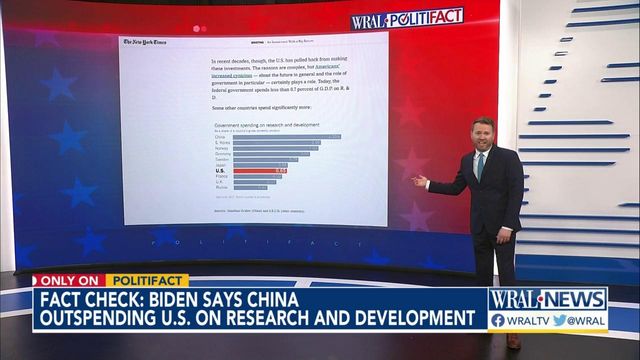Fact check: Is U.S. losing ground to China in research spending?
President Joe Biden spent the week before his State of the Union address touting rail tunnel projects in Baltimore and New York that would quicken trains and shorten commutes, courtesy of his administration’s $1 trillion Infrastructure Investment and Jobs Act.
But even as he celebrated domestic projects, Biden said the United States has been falling behind global rivals in research and development investment.
Research and development spending supports everything from agriculture to human health, national defense, manufacturing and energy, according to the Information Technology and Innovation Foundation, a nonpartisan think tank.
"We used to rank No. 1 in the world in research and development, now we rank No. 9," Biden said Jan. 30 in Baltimore. "China used to rank No. 8, now it ranks No. 2. The risk of losing our edge as a nation — and China and the rest of the world catching up — is real."
A White House spokesperson said Biden was referring to research and development spending as a percentage of gross domestic product. Biden did not say what time period he was using, and neither did the White House.
Our reporting found that Biden’s statement didn’t precisely match any of the nations’ specific rankings. But his claim contains a broader truth, in that China is narrowing the R&D gap with the United States and other nations.
The White House spokesperson pointed us to data from two sources: the Organization for Economic Cooperation and Development, which shows gross domestic R&D spending by multiple sources, and Massachusetts Institute of Technology economist Jonathan Gruber, who measured solely government-funded R&D spending.
The National Science Foundation, a federal agency, and the OECD are most often cited on this topic and calculate R&D spending differently. The foundation, for instance, draws from National Center for Science and Engineering Statistics data and examines trends but doesn’t rank nations, while OECD does provide rankings. Therefore, these data sources are more useful for capturing general trend lines than for comparing with each other.
• Changes in the U.S.: The Paris-based OECD, which collects statistics on advanced industrialized nations, doesn’t show the U.S. ranking as high as No. 1 during the past 20 years; but it does show the U.S. ranking as high as fourth in 2000. The U.S. fell to 10th in 2010, but rebounded to fifth in 2020, the most recent year for OECD rankings.
Meanwhile, the National Science Foundation also found that U.S. investment in R&D has fallen over time. It reported that U.S. federal R&D spending as a percentage of GDP hit a high of almost 1.9% in 1964 and has generally slid since, hitting 0.6% in 2017.
• Changes in China: The OECD found that over the same period the U.S. was declining, China’s spending was rising, from 17th globally in 2000 to 12th in 2020.
Also, the National Science Foundation found that China’ R&D outlays have increased from 0.89% of gross domestic product in 2000 to 2.23% in 2017.
Finally, the analysis by MIT’s Gruber had ranked the United States seventh and China first. A White House spokesperson who cited Gruber’s study said Biden chose to say that China ranked second because the number underpinning that China ranking is in dispute. The spokesperson didn’t elaborate.
Adjusting for purchasing power parities, which equalize GDP figures among countries with different currencies, China's R&D expenditures increased from 67% of U.S. expenditures in 2012 to 84% in 2021, and have continued to increase each year, said Robert D. Atkinson, president of the Information Technology and Innovation Foundation.
Atkinson said that if China continued gaining ground at that rate, it "would catch up to the U.S. in about 10 years."
He also urged caution when using data about Chinese R&D: Because of the Chinese central government’s pressure to report high numbers, Chinese companies and government organizations may be counting things as R&D that U.S. organizations don’t.
PolitiFact ruling

Biden said, "We used to rank No. 1 in the world in research and development, now we rank No. 9. China used to rank No. 8, now it ranks No. 2."
None of Biden’s rankings specifically match any we found from widely cited studies. But there is an element of truth about the overall trend: China has narrowed its international R&D spending gap with the U.S. and other nations in recent decades.
We rate his claim Mostly False.










